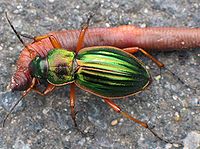
Photo from wikipedia
Biota dependant on early seral stages or frequently disturbed habitats belong to the most rapidly declining components of European biodiversity. This is also the case for Carabus nitens, which is… Click to show full abstract
Biota dependant on early seral stages or frequently disturbed habitats belong to the most rapidly declining components of European biodiversity. This is also the case for Carabus nitens, which is threatened across Western and Central Europe. We studied one of the last remaining populations of this ground beetle in the Czech Republic, which inhabits post-extraction peat bogs. In line with findings from previous studies, we show that C. nitens prefers patches characterized by higher light intensity and lower vegetation cover. Abundance of females was positively correlated with the cover of plant species requiring higher temperature. In addition, we demonstrate its preference for periodically moist, but not wet or inundated plots, suggesting that the transition between dry heathland and wet peat bog might be the optimal habitat for this species. This hypothesis is further supported by results showing a positive correlation between the abundance of C. nitens and vegetation cover comprising of a mix of species typical for heathland, peat bog, and boreal habitats. Our results show that C. nitens mobility is comparable to other large wingless carabids. The maximum covered distance was ~ 500 m in a month. To ensure the survival of this population, sites of recent peat extraction should be spared from reclamation and afforestation. In contrast, active measures should be taken to facilitate nutrient removal, disturbance of vegetation cover, and the creation of depressions with a humid microclimate. These actions will create a mosaic of heath, bog, and bare ground, which seems to be the preferred habitat of C. nitens at our study site.
Journal Title: Journal of Insect Conservation
Year Published: 2018
Link to full text (if available)
Share on Social Media: Sign Up to like & get
recommendations!